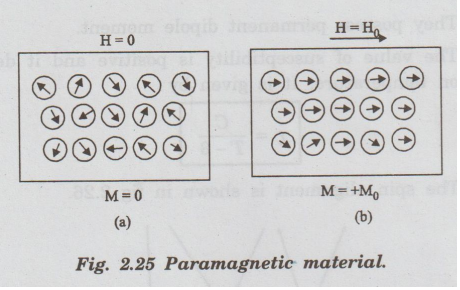Physics for Electrical Engineering: Unit II: b. Magnetic Properties of Materials
Paramagnetic Effect
Magnetic Properties of Materials
In certain materials, each atom or molecule possesses a net permanent magnetic moment (due to orbital and spin magnetic moments) even in the absence of an external magnetic field.
PARAMAGNETIC
EFFECT
In
certain materials, each atom or molecule possesses a net permanent magnetic
moment (due to orbital and spin magnetic moments) even in the absence of an
external magnetic field.
The
magnetic moments are randomly oriented in the absence of an external magnetic
field as shown in fig. 2.25(a). This makes the net magnetic moment zero and
hence the magnetisation of the material is zero.
But,
when an external magnetic field is applied, the magnetic dipoles tend to align
themselves in the direction of the magnetic field as shown in fig. 2.25(b) and
the material becomes magnetized.
This
effect is known as paramagnetism.
With
an increase in temperature, increase in thermal agitation disturbs the
alignment of the magnetic moments.
It
tends to randomize the dipole direction thus leading to decrease in
magnetization.

(a) Each atom possesses a permanent magnetic
moment. When H=0, all the magnetic moments are randomly oriented so M = 0.
(b)When a magnetic field H0
is applied, the magnetic moments tend to orient themselves in the direction of
the field, resulting in positive susceptibility
This
indicates that the paramagnetic susceptibility decreases with increase in
temperature. It is noted that the paramagnetic susceptibility varies inversely
with temperature.
Χ∞1/
T
χ
= C/T
This
is known as Curie's law of paramagnetism. C is a constant which is called as
Curie's constant.
Paramagnetic materials
The magnetic materials which
exhibit paramagnetism are called as paramagnetic material.
Properties
(i)
The paramagnetic materials attract the magnetic lines of force.
(ii)
They possess permanent dipole moment.
(iii)
The value of susceptibility is positive and it depends on temperature. It is
given by
Χ
= C / T- θ
(iv)
The spin alignment is shown in fig 2.26.

Example:
Manganous sulphate, ferric oxide, ferrous sulphate and nickel sulphate
Physics for Electrical Engineering: Unit II: b. Magnetic Properties of Materials : Tag: : Magnetic Properties of Materials - Paramagnetic Effect
Related Topics
Related Subjects
Physics for Electrical Engineering
PH3202 2nd Semester 2021 Regulation | 2nd Semester EEE Dept 2021 Regulation
